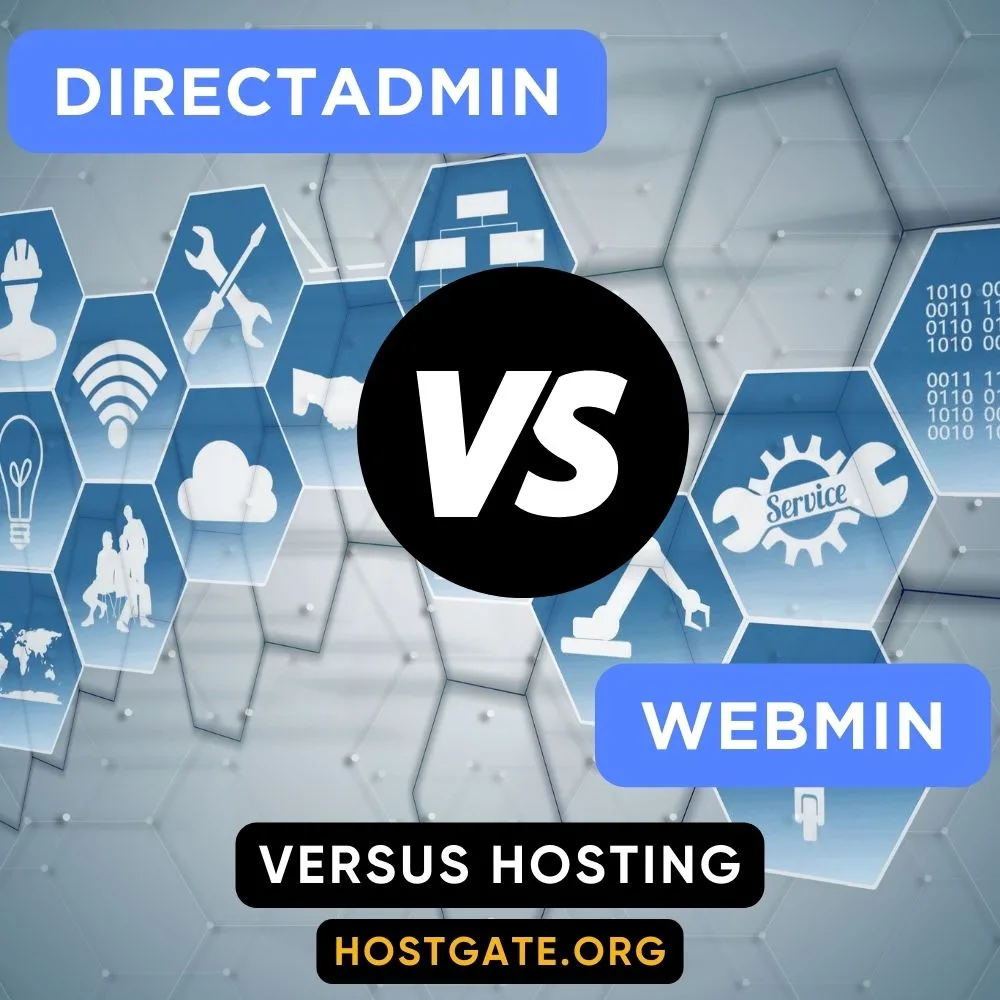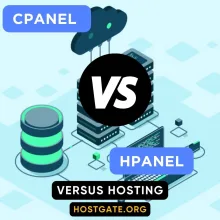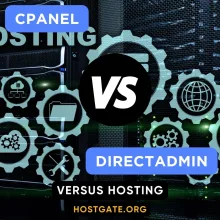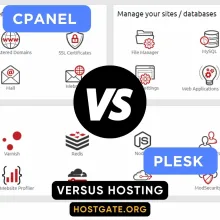DirectAdmin vs Webmin – Which One is Better? | HostingVS
DirectAdmin and Webmin are prominent web hosting control panels with distinct approaches to server management. DirectAdmin provides a lightweight, user-friendly interface optimized for CentOS and Red Hat Enterprise Linux, focusing on efficiency and minimal resource consumption. Webmin offers broader OS compatibility, extensive customization, and a comprehensive plugin ecosystem for technically advanced users.
Key differences include user interface design, performance characteristics, security implementations, and licensing models. DirectAdmin suits small to medium businesses seeking straightforward management, while Webmin caters to users requiring complex configurations. The choice depends on specific organizational needs, technical expertise, infrastructure requirements, and long-term server management strategies.

 Experience the Most Affordable and Reliable Cloud Web Hosting Cloud Web Hosting Starting at Just $3.99/month! - Unlimited Storage & Traffic - Free Domain Included - 24/7 Expert Support - Dedecated & VPS Hosting Plans |
DirectAdmin vs Webmin | DirectAdmin Control Panel | Webmin Control Panel |
Operating System Compatibility | Primarily supports CentOS and Red Hat Enterprise Linux | Broad compatibility across multiple Linux distributions (CentOS, Debian, Ubuntu) |
Resource Consumption | Lightweight, minimal system resource usage | More resource-intensive due to extensive feature set |
User Interface | Streamlined, intuitive interface for quick server management | Comprehensive, feature-rich interface for advanced configuration |
Plugin Ecosystem | Limited plugin options, focused native features | Extensive plugin marketplace with community-developed extensions |
Authentication and Security | Integrated two-factor authentication, straightforward security | Flexible authentication methods, comprehensive access control options |
DirectAdmin vs Webmin: A Comprehensive Comparison of Web Hosting Control Panels
Web hosting control panels are critical tools for server management, simplifying complex administrative tasks through intuitive web-based interfaces. DirectAdmin and Webmin stand out as prominent solutions, each offering unique approaches to server configuration, monitoring, and maintenance. Understanding their distinctive features helps administrators choose the most suitable platform for their specific infrastructure needs.
Technical Architecture: Foundations of Server Management
DirectAdmin and Webmin represent divergent technological philosophies in server management. DirectAdmin specializes in a lightweight, performance-optimized architecture primarily supporting CentOS and Red Hat Enterprise Linux, emphasizing efficiency and streamlined operations. Webmin, conversely, provides broader compatibility across multiple Linux distributions, prioritizing flexibility and extensive configuration capabilities. This fundamental difference impacts their deployment strategies and target user bases.
User Interface: Design Philosophy and Usability
The user interface represents a critical differentiator between these platforms. DirectAdmin delivers a streamlined, intuitive interface designed for rapid navigation and straightforward server management. Its clean design targets users seeking quick, efficient interactions with minimal learning curves. Webmin adopts a more comprehensive approach, offering a feature-rich environment that caters to technically proficient administrators who desire granular control and extensive configuration options.
Performance and Resource Management: Efficiency Considerations
Performance characteristics significantly distinguish DirectAdmin from Webmin. DirectAdmin is renowned for minimal resource consumption, making it ideal for smaller servers with limited computational resources. Its lean architecture ensures minimal overhead and efficient system utilization. Webmin’s more extensive feature set typically demands higher system resources, rendering it more suitable for robust, high-performance server environments that require complex management capabilities.
Security Features: Protecting Server Infrastructure
Security implementations vary substantially between these platforms. DirectAdmin integrates two-factor authentication and focuses on straightforward, robust security mechanisms. Its approach prioritizes essential protection with minimal complexity. Webmin provides more extensive security configurations, emphasizing comprehensive access control and flexible authentication methods. This allows advanced users to implement sophisticated security strategies tailored to specific organizational requirements.
Functionality and Package Management: Feature Ecosystem
DirectAdmin’s CustomBuild package management system represents a unique strength, enabling efficient software installation and management. This proprietary approach ensures streamlined updates and library management. Webmin compensates through an extensive plugin ecosystem, offering broader functionality via community-developed extensions. While DirectAdmin maintains a curated, focused feature set, Webmin thrives on adaptability and community-driven innovation.
Licensing and Cost: Economic Considerations
Licensing models reflect each platform’s target market and strategic positioning. DirectAdmin offers commercial licensing with professional support, appealing to businesses seeking reliable, vendor-backed solutions. Webmin provides open-source flexibility with community-driven support options, attracting budget-conscious users and organizations comfortable with collaborative troubleshooting. Pricing structures accommodate diverse organizational needs and budget constraints.
Migration and Cross-Platform Compatibility
Server migration capabilities differ between platforms. Webmin excels in cross-platform compatibility, supporting diverse operating system landscapes and facilitating seamless transitions. DirectAdmin specializes in smooth migrations within Red Hat-based environments, offering optimized performance for specific Linux distributions. Administrators must carefully evaluate their existing infrastructure when selecting a control panel.
Use Case Scenarios: Matching Platform to Requirements
Different organizational contexts demand distinct server management approaches. DirectAdmin suits small to medium businesses seeking straightforward, efficient server management with minimal complexity. Webmin caters to technically advanced users requiring extensive customization and complex configuration options. Enterprise environments might strategically leverage each platform’s unique strengths based on specific infrastructure requirements.
Advanced Administration: Scripting and Automation
Advanced administration capabilities reveal each platform’s strategic focus. DirectAdmin emphasizes simplicity and efficiency, providing essential server management tools with minimal overhead. Webmin offers deeper scripting capabilities, extensive API integration, and complex configuration options for sophisticated server environments. This fundamental difference determines their suitability for various technical scenarios.
Comparative Analysis: Strengths and Limitations
The comparison highlights DirectAdmin’s efficiency and user-friendliness against Webmin’s flexibility and extensive customization potential. DirectAdmin excels in resource-constrained environments requiring quick, straightforward management. Webmin provides unparalleled configuration depth for technically skilled administrators. Neither platform universally supersedes the other; instead, they offer complementary approaches to server administration.
Conclusion: Selecting the Right Control Panel
Choosing between DirectAdmin and Webmin requires carefully evaluating organizational needs, technical capabilities, and long-term server management strategies. Administrators must consider factors like budget, required features, technical expertise, and existing infrastructure. A thorough assessment of these platforms’ strengths and limitations ensures selecting the most appropriate solution for specific server management requirements.
Potential Downsides to Consider:
- DirectAdmin’s limited plugin ecosystem
- Webmin’s higher resource consumption
- Platform-specific compatibility constraints
- Varying levels of professional support
- Complexity of advanced configurations
By understanding these nuanced differences, organizations can make informed decisions about their web hosting control panel strategy, ensuring optimal server management and performance.
Summary and FAQs
What are the main differences between DirectAdmin and Webmin?
The main differences between DirectAdmin and Webmin are:
Architecture
- DirectAdmin: Lightweight, performance-optimized, primarily supports CentOS/Red Hat Linux
- Webmin: Broader Linux distribution compatibility, more flexible configuration
User Interface
- DirectAdmin: Streamlined, intuitive, quick navigation
- Webmin: Comprehensive, feature-rich, granular control
Performance
- DirectAdmin: Minimal resource consumption, ideal for smaller servers
- Webmin: Higher resource requirements, better for robust server environments
Security
- DirectAdmin: Straightforward two-factor authentication, essential protection
- Webmin: Extensive security configurations, flexible access control
Functionality
- DirectAdmin: CustomBuild package management, curated feature set
- Webmin: Extensive plugin ecosystem, community-driven extensions
Licensing
- DirectAdmin: Commercial licensing with professional support
- Webmin: Open-source with community support options
Use Cases
- DirectAdmin: Suited for small to medium businesses, simple management
- Webmin: Ideal for technically advanced users needing complex configurations
The key takeaway is that neither platform is universally superior; the choice depends on specific organizational needs, technical capabilities, and infrastructure requirements.
Is DirectAdmin or Webmin better for small businesses?
DirectAdmin is better for small businesses. The text specifically notes that DirectAdmin is suited for small to medium businesses seeking straightforward, efficient server management with minimal complexity. Its key advantages for small businesses include:
- Lightweight architecture
- Low resource consumption
- Streamlined, intuitive interface
- Quick server management
- Minimal learning curve
- Essential security features
- Efficient package management
Webmin, in contrast, is recommended for technically advanced users requiring extensive customization and complex configurations, which may be unnecessary and potentially overwhelming for small business needs.
Which platform offers better security features?
Based on the article, Webmin offers more comprehensive security features:
Webmin:
- Provides extensive security configurations
- Offers flexible authentication methods
- Enables sophisticated, tailored security strategies
- Emphasizes comprehensive access control
DirectAdmin:
- Integrates two-factor authentication
- Focuses on essential protection
- Maintains straightforward, minimal complexity security mechanisms
For organizations requiring advanced, customizable security options, Webmin appears superior. For businesses seeking basic, uncomplicated security, DirectAdmin provides adequate protection.
How do the licensing models differ between DirectAdmin and Webmin?
According to the article, the licensing models differ as follows:
DirectAdmin:
- Commercial licensing
- Offers professional support
- Targets businesses seeking reliable, vendor-backed solutions
Webmin:
- Open-source licensing
- Provides community-driven support options
- Attracts budget-conscious users
- Supports collaborative troubleshooting
The key distinction is that DirectAdmin provides a paid, professionally supported model, while Webmin offers a free, community-supported approach. The choice depends on an organization’s budget, support needs, and comfort with community-based assistance.
Can I migrate between DirectAdmin and Webmin easily?
Migration between DirectAdmin and Webmin has some challenges:
Webmin advantages:
- Excels in cross-platform compatibility
- Supports diverse operating system landscapes
- Facilitates seamless transitions
DirectAdmin limitations:
- Specializes in migrations within Red Hat-based environments
- Optimized for specific Linux distributions
The article suggests that migration isn’t necessarily easy and recommends carefully evaluating existing infrastructure before selecting a control panel. Administrators must consider platform-specific compatibility constraints when planning migrations.





